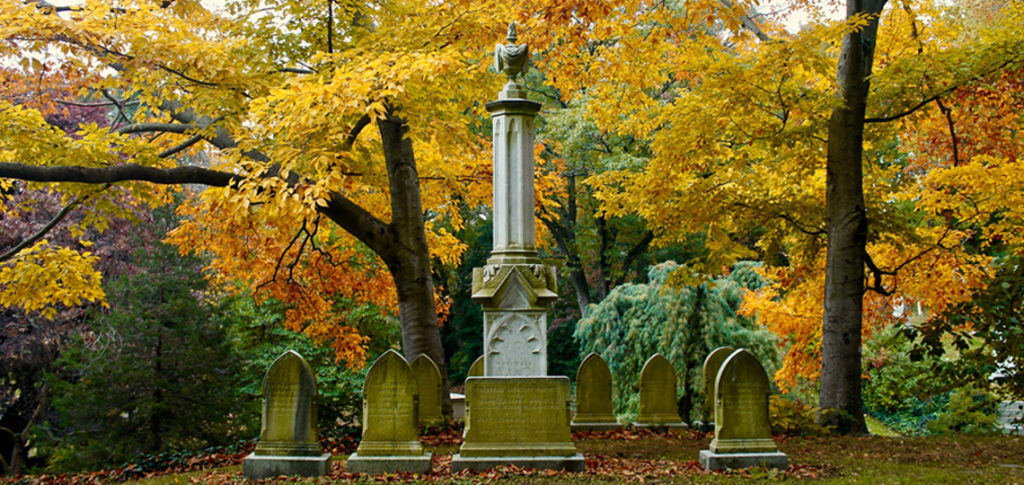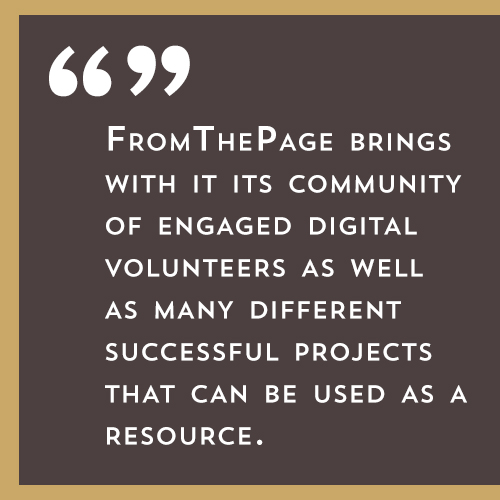
Meg L. Winslow and Thom Burns of the Mount Auburn Cemetery in Cambridge, Massachusetts kindly took the time to answer questions from Sara Brumfield of FromThePage, and discussed their project and experience using the platform.
Winslow is Curator of the Historical Collections & Archives at Mount Auburn Cemetery, where she oversees the Cemetery’s permanent collections including the archives, library, photograph collection, fine and decorative arts, and significant monuments.
Burns is a technical art historian and a part-time Curatorial Consultant in the Historical Collections & Archives. Burns conceived, implemented, and co-manages the project.
First, tell us about your documents.
Meg: Many researchers will be surprised to learn that our documents are much more than old, musty records of the dead.
Founded in 1831 as the first rural cemetery in America, Mount Auburn is an important site of burial and commemoration. It is also a multi-functional institution founded by horticulturalists and pre-professional landscape designers, an internationally renowned arboretum and botanical garden, wildlife refuge, and community resource.
Our documents in From the Page date from 1831 to the 1930s and include trustee minutes and reports, commissions for works of art and stained glass, and a collection of 65 copying books filled with letters between Superintendents, Secretaries, Treasurers, and Lot Owners.
Trustee minutes tell the story of Mount Auburn’s designed landscape and how it set the pattern for our country’s public parks and suburbs. Letters show how the Cemetery staff worked to professionalize the landscape while working with families who were seeking to shape lots to their personal tastes.
Reports and accounts show how every profession was evolving –civil engineering, gardening, landscape design, monument-building, record-keeping, accounting, and real estate. These records reflect a time of incredible growth that included the creation of a greenhouse and nursery, the appointment of a permanent gardener's position, the installation of fountains in the ponds, and the creation of a committee to “protect, encourage and introduce birds within the property.”
Together, they tell the story of the rural cemetery movement and provide insight into the thinking and vision of Mount Auburn’s founders and the remarkable individuals from Boston and New England who helped to shape our country.
Thom: The great thing is that by transcribing these documents, researchers and the general public will have a better understanding of the breadth of information included in our archives. So many people have a preconception of what materials are held in a cemetery archive, but we think our documents will show how much more there is.
What are your goals for the project?
Meg: The project, which began as a great way to engage our collections staff and volunteers during the COVID-19 pandemic, became a much broader, mission-driven initiative to bring our collections to the public, and the public to our collections.
Thanks to the contributions of our 90+ volunteer collaborators, we’ve been transcribing about 100 pages per week which means we’ll be able to transcribe about 4,000 pages by the end of December.
Our goals are to make Mount Auburn’s most important early documents readable, searchable, and accessible to as many people as possible and to make our unique history available to everyone, anywhere in the world.
Thom: This project has grown in wonderful ways we did not expect and thus we have added new goals along the way.
We have realized that there are many volunteers all over the world, who have spent hours working within our collections. These transcribers may never have visited Mount Auburn. We want to support this growing group of digital volunteers and allow for a whole new group of people to connect with our material and more importantly, to Mount Auburn for the first time.
How are you recruiting or finding volunteers/collaborators?
Meg: Mount Auburn is fortunate to have a vibrant community of volunteers and docents.
As our core group of volunteer transcribers, they’ve been eager to engage with the Cemetery and make a difference. From there, we’ve reached out to our wider community with articles on our website and social media accounts. It helped immensely that we received a National Endowment for the Humanities (NEH) CARES grant to support the project.
Articles in Antiques and the Arts Weekly and Landscape Architecture Magazine have also helped to spread the word. We have been delighted to learn that some of our volunteers found the project on the FTP site as well. This week, we look forward to holding our first “transcribe-a-thon.”
Thom: Our colleagues have been gracious and instrumental in sharing the transcribing project with Cemetery docents, publishing articles in the Cemetery e-newsletter and on the website, and posting on social media.
We've also utilized our collection's Instagram site: @MtAuburnHistoricalCollections to encourage our followers to join and to share stories and discoveries that transcribers make along the way.
Meg: Our goals include not only growing the project but also sustaining it for the long term.
We created a monthly email newsletter to thank transcribers, celebrate milestones, share updates, and show the impact that the project is having. We also just held our first “virtual get-together” over Zoom to meet transcribers and to get to know each other. It was a great way to learn how our volunteers first connected to the project and what they like about it.
It was inspiring to hear their stories of wanting to make a positive impact, make a difference, and be useful.
Can you share your experience using From the Page?
Thom: Our From the Page project represents the confluence of pre-existing digitized images and a desire to make our collection more widely available to the public. The COVID-19 pandemic served as a catalyst to make it all happen.
When I joined the Historical Collections & Archives team nearly two years ago, I was surprised by the sheer volume of records that had been digitized. These images were only accessible through our internal servers and not yet available online.
Before the pandemic we had just launched our online collections database. This database allows the public to search the catalogue records of our collections ranging from letters, reports, books, photographs, objects, and other visual materials.
Then came the pandemic. We suddenly shifted to remote work and no longer had access to the physical collections. Only Meg could connect to our servers, digital files, and software programs. I knew that part-time consultants, including myself, would not be able to work on our current projects.
The best way to secure my job was to find a way to involve my colleagues remotely. I was familiar with transcribing projects while interning at the Archives of American Art and utilized an AI driven transcribing program while in graduate school. From my previous experience, I knew that since Mount Auburn already had digitized their material, all we needed was a system to transcribe remotely.
I didn’t see anything that could get us up and running immediately until I found FromThePage.
Using a demo collection, I was able to show Meg a proof of concept. FromThePage offered the transcribing interface, image hosting, and allowed for later export, making it the overall best solution. A big draw was the ability to directly link a transcribed volume in FromThePage to the corresponding record in our collections database.
What started as a way to keep our community of staff and volunteers engaged, quickly turned into something much greater. Initially, the project was conceived to make our documents more accessible to the public, but I did not fully appreciate how instrumental the public would be to the process.
How does FromThePage & crowdsourcing fit for a historic site?
Thom: First, I think every historic site already functions on crowdsourcing.
Volunteers are integral to the success of any historic site. FromThePage’s collaborative nature and multiple roles involved in this type of project make it a perfect fit. While transcribing is the main task, people can contribute by digitizing, image editing, public outreach, and copy editing.
Historic sites, by their nature often have a much more eclectic range of materials and objects than a typical archive or museum. Plus, the software used to manage the collection can range from an excel sheet to ones that are the best of industry standards. FromThePage can provide a historic site’s first foray into the online world, or it can be folded into a pre-existing online database, like PastPerfect in our case.
Finally, FromThePage brings with it its community of engaged digital volunteers as well as many different successful projects that can be used as a resource. Only after launching our project, did we realize that many of our most active volunteers are connecting with Mount Auburn for the first time, virtually. With FromThePage you are getting both a wonderful software and a thriving community.
Meg: With many different ways of cataloguing materials and such varied collections systems for historic sites, it can often be challenging to add new platforms or products. FromThePage has been surprisingly easy to integrate within our own existing systems. It worked right off the shelf and hasn’t required staff training – users can jump right in and set to work.
What would you tell folks considering a similar project?
Thom: I see your crowdsourcing project as a rolling snowball.
There are many ways to make it grow and keep it moving forward. It is best to not just focus on one thing. You can easily spend time over planning, because the processes you begin with will inevitably change as you get going.
Work on getting the ball rolling and making sure that your workflows and conventions will get you to your goal. Know that you might hit a bump or two along the way. You might notice that there is a bottle neck in your workflow. Your project might suddenly pick up momentum and you need more hands working on one task than before.
After you launch your project, the most important work is building momentum and sustaining the enthusiasm. Everyone on our team had to be nimble and filled different roles that arose as the project took off.
Meg: Absolutely, I would tell everyone to consider a project like this. FromThePage has helped create connections with volunteers all over the world, many of whom have never even been to Mount Auburn. As a Cemetery, we’ve been able to engage the public in ways we never thought possible and given new relevance to old records. What’s more, we’re enjoying it.
